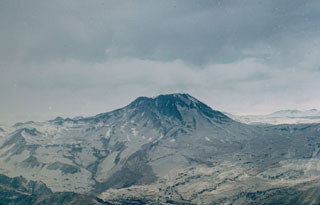Report on Descabezado Grande (Chile) — March 1982
Scientific Event Alert Network Bulletin, vol. 7, no. 3 (March 1982)
Managing Editor: Lindsay McClelland.
Descabezado Grande (Chile) New fumarole in main crater
Please cite this report as:
Global Volcanism Program, 1982. Report on Descabezado Grande (Chile) (McClelland, L., ed.). Scientific Event Alert Network Bulletin, 7:3. Smithsonian Institution. https://doi.org/10.5479/si.GVP.SEAN198203-357050
Descabezado Grande
Chile
35.58°S, 70.75°W; summit elev. 3953 m
All times are local (unless otherwise noted)
Fumarolic activity was observed on the morning of 19 March. A white plume was rising from the summit crater during the 3 hours the observer was on Nevados de Chillán Volcano, 160 km to the S. The only recorded eruption at Descabezado Grande, in 1932, was from a crater at its NE foot. Weak fumarolic activity has been reported on the W slope at about 3,500 m, but none had previously been observed in the main crater.
Geological Summary. Volcán Descabezado Grande is a late-Pleistocene to Holocene andesitic-to-rhyodacitic stratovolcano with a 1.4-km-wide ice-filled summit crater. It lies at the center of a 20 x 30 km volcanic complex, 7 km N of the Cerro Azul stratovolcano. A lateral crater, which formed on the upper NNE flank in 1932 shortly after the end of the major 1932 eruption from nearby Quizapu cone on the N flank of Cerro Azul, was the site of the only recorded eruption. The Holocene Alto de las Mulas fissure on the lower NW flank produced young rhyodacitic lava flows. Numerous small late-Pleistocene to Holocene volcanic centers are located N of the volcano. The northernmost of these, Lengua de Vulcano (or Mondaca), produced a very youthful rhyodacitic lava flow that dammed the Río Lentué.
Information Contacts: H. Moreno R., Univ. de Chile, Santiago.

